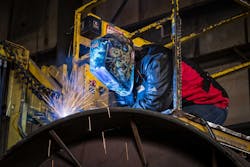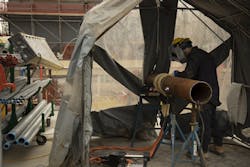In a welding shop, workers have a choice: complete their work according to safety standards, or overlook the precautions that keep them safe. Although welding should not be dangerous when performed correctly, serious bodily harm is unavoidable without proper protection methods and equipment. Because of this, when it comes to any welding project, safe welding should always be a top consideration. In an equipment shop, however, knowing what to keep an eye out for can be half the battle.
Even as a beginner, numerous safety hazards can be avoided by observing the type of weld a worker is performing. For example, several welding processes produce dangerous levels of ultraviolet light (UV) and infrared radiation (IR), all of which are primarily housed under one type: arc welding. With arc welding, the intense heat needed to melt metal is produced by an electric arc, formed by an electric current flowing between a stick or wire electrode. By applying intense heat, two metal parts are joined together, causing them to intermix directly, or with a molten filler metal.
Although generating a welding arc is necessary, the intense UV produced from the arc can cause several injuries to the eyes and skin. Without the correct eye protection, for example, ultraviolet radiation can cause “arc flash,” essentially a sunburn on the surface of the eye. This causes intense pain and puffy, red eyes from the tearing of membranes around the eye.
PPE for safe welding
“You’ve got to wear safety glasses and helmets in order to prevent your eyes from getting damaged from the arc,” Jim Byrne, sales and applications manager with Miller Electric, says. “If you don’t have protective lenses on that’ll darken that arc, the ultraviolet can penetrate.”
Although symptoms clear up within a day or so, the likelihood of permanent damage increases with the frequency of exposure. Long-term exposure to UV light can even produce cataracts.
Welders, or any worker near the welding area, may not notice symptoms of welding flash for a few hours after UV exposure. Anyone within sight is susceptible to the risks from light emissions.
“If someone is working on a pipe in a yard and there are other workmen in the vicinity, there needs to be some safe screening of the weld to protect all workers or passersby,” says Guy Shelverton, ESAB’s product manager.
“Traditionally, that would be a welding curtain, a welding frame that houses a welding curtain that would capture the rays that are coming out. You would pen the welder in using these curtains to ensure any passersby are protected from the UVIR light.”
At a minimum, anyone working in the welding environment should be wearing safety glasses, even if not directly involved, in order to ensure safe welding. For the welder, a full face shield with a shaded lens or an auto-darkening helmet is crucial for protection from the arc.
According to Chase Rutti, product manager of PPE at Lincoln Electric, this is the reason automatic-darkening helmets have come onto the market within the past 10 to 15 years, as opposed to traditional “passive” helmets.
A passive helmet has a piece of glass or polycarbonate with a fixed shade, traditionally at 10 or 11. The operator is only able to see through the lense after an arc is initiated, and cannot adjust the shade tint. An auto-darkening helmet has variable shades.
“An auto-darkening helmet uses a UV and IR coated liquid crystal display (LCD), which in the inactive state, filters visible light at shade 3 or 4,” Rutti says. “This inactive state allows operators clear visibility to setup, inspect, and even grind.
“As the operator strikes an arc, the helmet lens automatically darkens to filter visible light at the operator’s chosen shade, which would normally be between shade 8 to shade 13. This automatic process is initiated once the lense’s light sensors detect the energy of a welding arc, ,and the transition occurs within 1/25,000 of a second.”
Miller engineers welding hoods that will detect the arc, and darken the shade for the welder automatically.
UV Radiation Also Poses Skin Risk
In addition to arc flash, long-term exposure to UV radiation will burn unprotected skin, similar to UV radiation from sunlight. With time, lack of protection can lead to second- and even third-degree burns. Radiation that is reflected from metal surfaces can also damage the skin.
Welding gloves protect the worker’s hands and wrists from radiation, along with spatter and sparks produced while welding. Heavy-duty boots, welding bibs, and aprons are also an option, depending on the level of protection a welder is looking for. Sleeves provide the welder with protection from the armpit to the wrist. Sleeve fabric should be flame-resistant cotton, leather, or Kevlar knit.
To learn which PPE your welding application requires, refer to ANSI Z49.1, “Safety in Welding and Cutting,” as well as the manufacturers’ instructions and safety data.
“Those are areas where we can really help people, because when the arc is not on, your lense is lighter and you can keep your hood down,” Byrne says. “When operators keep their hoods down even when they’re not welding, it improves safety and productivity.”
The combination of helmets and safety goggles ensure the welder is protected at all times as light bounces off of different surfaces in the welding environment, and helps promote safe welding.
“Obviously it’s very dangerous to look directly at a welding arc if you haven’t got the right protection,” Shelverton said. “UVIR rays are damaging to the skin cells as well, so that’s also important that you have full face protection, not just googles that are protecting your eyes, but a proper welding helmet that’s protecting your full face, neck, chin, and head.”
Avoid fumes for safe welding
Since metal is vaporized during certain types of welding—such as oxy-fuel, plasma cutting, and brazing—these process produce harmful gases called metal particulate fume. If inhaled, these fumes can damage a welder’s lungs. Metal particulate can contain a range of metals including aluminum, arsenic, beryllium, lead, and manganese. Other gases produced from a weld that displace oxygen—such as helium, carbon dioxide, and argon—can also pose suffocation risks, especially in enclosed spaces.
“On average, inhaling particulate fume is four to five times more dangerous than cigarette smoke,” Shelverton says. “So protection awareness has become more prevalent in the last five to 10 years.”
Prolonged exposure to welding fume may even result in lung damage, and various types of cancer including lung, larynx, and urinary tract.
“There have been more and more lawsuits centering around respiratory problems in ex-welders,” Shelverton says. “It’s now becoming apparent that some of these health issues were a direct result of exposure to welding fume particulate.”
Shelverton says the welders of today are becoming more “savvy” when it comes to the dangers around welding fumes, as well as seeing an increase in respiratory products available as a combined solution.
“The average age of a welder in Europe is 65 (55 in the U.S.), so getting the older generation to start wearing power respiratories is quite difficult,” Shelverton says. “But the laws are now changing, and I think within the next few years we could see that a full-face respirator becomes mandatory during welding processes. It’s not currently, but end users and customers are now becoming more and more alert about the dangers, and there’s more obligation to provide respiratory equipment for welders.”
The respiratory risk is much less when welding outdoors. However, workers are advised to stay upwind when welding in open or outdoor environments, and use natural drafts to keep fumes and gases away from themselves and other workers.
“When you’re welding outside, the fumes are just going up into the atmosphere, so obviously the risk is much less,” Shelverton says. “It’s not so much an issue because you’re outside.”
To protect themselves from particulate fume, welders must first look at the consumable product that they’re using, or the philometals that are being used. Philometals produce the fume. The next step would be ensuring there is adequate ventilation in the welding environment.
“PPE is the last resort really, because that is the last defense against the actual individual,” Shelverton said. “There are a number of different PPE options a welder could choose when he’s looking at respiratory protection.”
If welders are looking for PPE as standard as a T3 rated disposable mask, they can wear that piece underneath their helmet.
“It’s very cheap, it’s disposable, it’s a low-cost option for providing protection as long as it has the correct level, IEP 3, which is the highest level,” Shelverton says.
Local exhaust ventilation systems can also be used to remove fume from the welder’s breathing zone. A powered air respirator is one example, which is a belt-on unit powered by a lithium battery. The device filters the air from the surrounding environment through a P3 filter, a class of filter that is used for all particulates, and requires high protection factors. The P3 filter then channels the air into the direct breathing zone of the welder.
There are also self-contained breathing apparatuses (SCBA) that require a full gas tank strapped to the back of the welder, with a full face mask. This is generally used for welding in a confined space. These respirators provide a supply of air for up to an hour.
OSHA defines a confined space as “a space that is large enough and so configured that an employee can bodily enter and perform assigned work, has a limited or restricted means of entry or exist, or is not designed for continuous employee occupancy.”
“A powered air unit is only filtering the ambient air, so as long as there’s oxygen in there, it’s going to be filtering the particulates and providing clean air into the breathing zone,” Shelverton says. “But when a welder is in a confined space, and there’s potential for a lack of oxygen, a normal powered air unit is not going to create oxygen. That’s when we recommend a breathing apparatus where you’ve got a contained oxygen source on the back, so a welder is getting fresh air into their breathing zone.”
For safe working conditions, the oxygen level in a confined space must range between 19.5 percent and 23.5 percent. Anything below is considered deficient. Shelverton says a confined space can also be defined by how much fume is being produced.
“If a guy is welding inside of a tank and producing all these gases, then that is a confined space,” Shelverton said. “But even if he’s in a larger area, and he’s producing a lot of fume and gases, and the oxygen level is low, that could also be defined as a confined space.”
Since confined spaces can appear in all sizes, it is important for end users to test the levels of oxygen in the environment employees are working in.
“Obviously as you’re producing all of these welds you’re producing a lot of different gases,” Shelverton said. “By the time the oxygen level can decrease, that really depends on what’s being welded, the application, and the immediate environment.”






